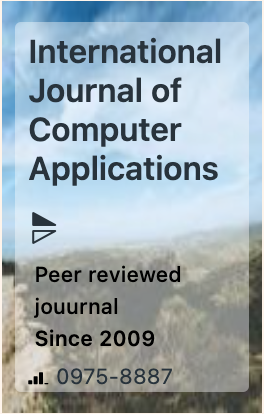The week's pick
Random Articles
Reseach Article
Optimizing Noise Reduction in Images with the Lord Rama Devotee Algorithm
| International Journal of Computer Applications |
| Foundation of Computer Science (FCS), NY, USA |
| Volume 186 - Number 69 |
| Year of Publication: 2025 |
| Authors: Abhishek Patel |
 10.5120/ijca2025924541
10.5120/ijca2025924541
|
Abhishek Patel . Optimizing Noise Reduction in Images with the Lord Rama Devotee Algorithm. International Journal of Computer Applications. 186, 69 ( Mar 2025), 61-67. DOI=10.5120/ijca2025924541
Abstract
In this study, the Lord Rama Devotee Algorithm (LRDA), a novel evolutionary optimization technique inspired by the devotion of Lord Rama’s followers to optimizing noise reduction in image processing is presented. LRDA is a new idea that is inspired by the Indian Knowledge. LRDA simulates the collective intelligence of devotees to search for optimal solutions through position and velocity updates. The algorithm is applied to optimize filtering parameters for two types of noise: Gaussian noise and Salt and Pepper noise. For Gaussian noise, LRDA optimizes the sigma value of a Gaussian filter, improving the Peak Signal-to-Noise Ratio (PSNR) to reduce noise while preserving image details. Similarly, for Salt & Pepper noise, the algorithm adjusts the window size of a median filter, aiming to achieve the best noise removal performance without compromising image quality. By simulating the behavior of devotees and non-devotees, LRDA updates both personal and global bests to maximize the PSNR. Experimental results demonstrate that LRDA effectively optimized the Gaussian filter’s sigma value to achieve a PSNR of 25.34, while the median filter for Salt & Pepper noise was optimized to yield a PSNR of 27.02. These results confirm LRDA’s ability to handle different noise types, providing an adaptive and flexible solution for image noise reduction while maintaining visual detail. The algorithm's devotion-inspired mechanism efficiently balances noise reduction with image preservation, making LRDA a promising tool for image processing applications.
References
- Kumain, S. C., Singh, M., Singh, N., and Kumar, K. 2018. An efficient Gaussian Noise Reduction Technique for Noisy Images using optimized filter approach. First International Conference on Secure Cyber Computing and Communication (ICSCCC). https://doi.org/10.1109/icsccc.2018.8703305
- Devasena, D., Jagadeeswari, M., Sharmila, B., and Srinivasan, K. “Optimization Techniques for Removing Noise in Digital Medical Images”, Nature‐Inspired Algorithms Applications, 2021, 243–266. https://doi.org/10.1002/9781119681984.ch9
- Kavitha, K., Shanmugam, A., and Imoize, A. L. “Optimized deep knowledge-based no-reference image quality index for denoised MRI images”, Scientific African, 20, e01680, 2023. https://doi.org/10.1016/j.sciaf.2023.e01680
- Kim, H., Lim, S., Park, M., Kim, K., Kang, S., and Lee, Y. “Optimization of Fast Non-Local Means Noise Reduction Algorithm Parameter in Computed Tomographic Phantom Images Using 3D Printing Technology”, Diagnostics, 2024, 14(15), 1589. https://doi.org/10.3390/diagnostics14151589
- Pancholi, B. K., Modi, P. S., and Chitaliya, N. 2022. A Review of Noise Reduction Filtering Techniques for MRI Images. 5th International Conference on Contemporary Computing and Informatics (IC3I). https://doi.org/10.1109/ic3i56241.2022.10073389
- Thakare, S. S., and Kale, S. N. “Noise reduction technique in scanned document using Cuckoo optimization algorithm”, International Journal of Engineering and Advanced Technology, 2019, 8(6s), 331–335. https://doi.org/10.35940/ijeat.f1069.0886s19
- Nabahat, M., Khiyabani, F. M., and Navmipour, N. J. “Hybrid noise reduction filter using the Gaining–Sharing Knowledge-Based Optimization and the whale Optimization algorithms”, SN Computer Science, 2024, 5(4). https://doi.org/10.1007/s42979-024-02674-y
- Işıl, Ç., Gan, T., Ardic, F. O., Mentesoglu, K., Digani, J., Karaca, H., Chen, H., Li, J., Mengu, D., Jarrahi, M., Akşit, K., and Ozcan, A. “All-optical image denoising using a diffractive visual processor”, Light Science & Applications, 2024, 13(1). https://doi.org/10.1038/s41377-024-01385-6
- Gajawada, S. “Lord Rama devotees Algorithm: a new Human-Inspired Metaheuristic Optimization Algorithm”, SSRN Electronic Journal, 2023. https://doi.org/10.2139/ssrn.4590052
Index Terms
Keywords

